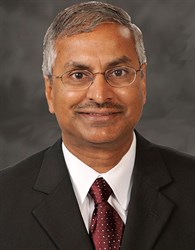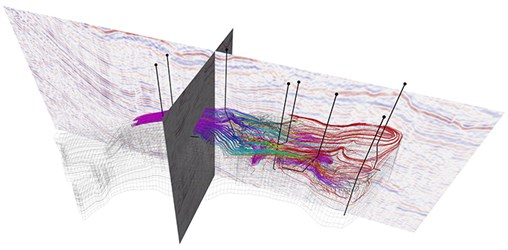 A significant increase in small-scale seismic activities has taken place in Texas since 2010. Although many of these activities are not ‘felt’ or cause damage, it is important to know the cause for such an increase.
A significant increase in small-scale seismic activities has taken place in Texas since 2010. Although many of these activities are not ‘felt’ or cause damage, it is important to know the cause for such an increase.
Dr. Akhil Datta-Gupta, University Distinguished Professor in the Harold Vance Department of Petroleum Engineering at Texas A&M University, is leading a project to model reservoir behavior and in-situ stress conditions near faults. Datta-Gupta’s efforts might determine if well activities such as fluid injection and production near a fault have a potential link with earthquakes, and his goal is to find the range of oil and gas operating conditions and geologic subsurface parameters that can lead to earthquake activities.
Joining Datta-Gupta on the project are Dr. Michael King, the LeSuer Chair in Reservoir Management in the department, and Dr. Jihoon Kim, an assistant professor in petroleum engineering.
Earlier this year Gov. Greg Abbot appointed a committee to oversee the purchase and deployment of seismic equipment across Texas. The committee will advise the Bureau of Economic Geology at the University of Texas at Austin, in conjunction with the TexNet Seismic Monitoring Program, on creating the seismic network that will provide data to Datta-Gupta. Datta-Gupta’s project will handle the modeling of reservoir behavior for systems of wells in the vicinity of faults in Azle, Texas, where there has been recent incidents of seismic activity, and submit findings to the committee.
“Earthquakes are typically caused by activations of fault systems or fault networks,” said Datta-Gupta. “These faults are activated whenever there is a change in stress conditions. Some of these faults may be in critical stress, so it wouldn’t take much to actually cause a fault slip, which could trigger seismic activity.”
Fluid injections are one potential trigger. Oil and gas production often produces significant amounts of brackish water and this water is either injected back into the formation in a process called water flooding, or taken to a regulated waste fluid disposal well, often hundreds of miles away, and injected there.
According to The United States Geological Survey, of the more than 150,000 Class II injection wells in the United States, roughly 40,000 are waste fluid disposal wells for oil and gas operations. Only a small fraction of these disposal wells have induced earthquakes that are large enough to be of concern to the public.
Datta-Gupta is studying one of the few known areas that might help understand that small fraction. He is concentrating his research on Azle, Texas because the area around it experienced several magnitude 2 or greater earthquakes during 84 days from November 2013 to January 2014. There are two disposal wells in the area that could possibly be linked to the activity.
“There are two main goals,” said Datta-Gupta. “First, the bureau will monitor (the seismic network) to document and catalog any seismic activity, particularly of magnitude 2 or greater. The second determines potential linkage between fluid injection and the seismic activities (through modeling).”
 Datta-Gupta’s project will use seismic data from the bureau, data from wells drilled nearby and publicly available geologic information to construct three-dimensional computer models of the subsurface. He will then model the fluid flow through the subsurface and look for critical stress factors.
Datta-Gupta’s project will use seismic data from the bureau, data from wells drilled nearby and publicly available geologic information to construct three-dimensional computer models of the subsurface. He will then model the fluid flow through the subsurface and look for critical stress factors.
“We are not here to make a definite prediction, such as: if you do this then this will happen,” he said. “What we are mainly looking at is the sensitivity. A major part of this, I think, is to understand boundaries. What are the ranges of subsurface and operating parameters that might lead to some sort of connection between fluid injection and seismicity?”
Datta-Gupta began digitally modeling subsurface activities while working toward his master’s degree at the University of Texas, and was in on the ground floor of the widely used UTCHEM program for modeling chemically enhanced oil recovery. Years later, he worked with King while at BP to create a faster modeling process called streamline simulation which is now routinely used in reservoir engineering practice.
Modeling has become his specialty.
“We can put in all these complexities when it comes to geologic heterogeneity, and we can do the computations at a much faster pace if we focus on the dominant physics,” said Datta-Gupta. “What are the major flow paths in the subsurface? How fast is fluid flowing through these flow paths? With streamlines, we think of the reservoir as made up of highways. How long does it take the fluid to flow on these highways and where are these highways going?”
Now that he and King are both professors at Texas A&M, they have collaborated on a streamline modeling textbook, the Modeling Calibration and Efficient Reservoir Imaging joint industry project, and novel approaches to model pressure propagation in unconventional reservoirs.
“My students apply the basic principles they learned in high school — mass is conserved, energy is conserved and momentum is conserved,” Datta-Gupta said. “The question is how these principles translate into solving practical problems. That’s what engineering is all about. You take a knowledge base and then translate it into mathematical equations. Then you solve them to answer specific questions.”